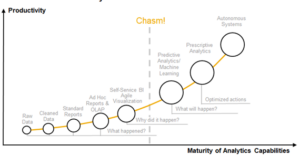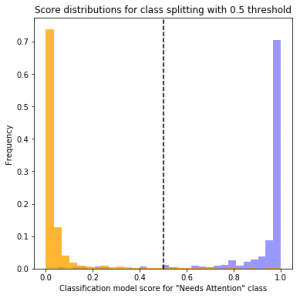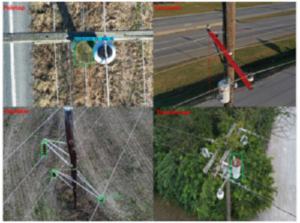
AI should fuel digital transformation, not hinder it.
The Digital Transformation Landscape
As businesses adapt to the rapidly changing competitive landscape, many are pursuing Digital Transformation (DX) initiatives to increase business agility, improve operational insights, reduce costs, and enhance customer intimacy. In fact, research firm IDC reports worldwide spending on Digital Transformation will reach $2.3 Trillion in 2023. As the COVID-19 Pandemic has shown us, organizations that have embraced digital transformation are more poised for future success than those who have not.
The changes that have occurred during the pandemic in the grocery store operating model is a great case study in business agility fueled by Digital Transformation. While online grocery selection and curbside pickup were available prior to the COVID-19 outbreak, their usage exploded in early 2020 as consumer preferences abruptly changed. Those companies that rapidly adapted to the changing environment by updating technology, people, processes, and company culture were able to quickly capitalize on market share opportunities and gained significant exposure in the media as innovative problem solvers. DX investments occurred across many industries, with video conference providers deploying analytics to predict and handle demand surges and healthcare providers modeling the risks of deferring specific procedures until after the pandemic passed.
Why is an AI & ML Company Talking about DX
Mosaic has worked with many organizations to develop data science and AI solutions to their most challenging problems. In our work, we’ve seen organizations with varying degrees of digital maturity, with our goal being to meet our customers wherever they are and to provide catalyst solutions in their digital journeys. If you feel like you’re behind the curve, you’re not alone; according to Gartner, 85% of businesses are still relatively immature in adopting analytics and AI into their workflow. As you can see in the graphic below, the leap between self-service business intelligence capabilities and machine learning is large, but that gap is the point of inflection where returns start to climb rapidly.
Mosaic believes an AI and digital transformation approach needs to be comprehensive and starts with an organization’s business objectives. To achieve transformation, an organization needs to create solutions with balanced plans for the people, process, culture, and technology elements as aligned parts of the overall transformation.
Mosaic examines three AI & digital transformation projects we supported for three very different organizations in the following sections.
Classifying Purchase Orders with NLP | Improving Employee Tasking
Many hospital systems receive thousands of purchase orders (PO) each week to keep the facilities stocked with the products and equipment necessary for healthcare professionals to perform their day-to-day functions, from administrative tasks to sophisticated surgeries. For one of the largest healthcare systems in the United States, this is no small feat. The Supply Chain department determined that a machine learning tool for automatically flagging emails requiring attention as they arrived in the PO confirmation mailbox would reduce the risk of missed exceptions and significantly reduce the workload on the Supply Chain department.
Rethinking Time-Consuming Processes
Staff members of a small customer service team within the Supply Chain department manually review the PO confirmations received in the designated email account to ensure that exceptions are routed appropriately and promptly addressed. Examples of standard exceptions include backorder or discontinued product notifications, price changes that need to be acknowledged before the order will be processed, or errors in the PO, such as unknown product numbers, that require the healthcare provider to submit a revised PO. Due to the sheer volume of POs placed weekly and the team’s other competing duties, there are often exceptions that slip through unnoticed. Missed abnormalities cause downstream issues through the supply chain that can have very high costs – such as last-minute surgery postponements due to missing equipment that can negatively affect patient health and outcomes and are costly to a hospital’s bottom line.
AI to the Rescue
Mosaic and the Supply Chain department determined that an AI tool for automatically flagging emails requiring attention as they arrived in the PO confirmation mailbox would reduce the risk of missed exceptions and significantly reduce the workload on the Supply Chain department.. Mosaic worked with the hospital as an analytics consulting partner to implement Natural Language Processes (NLP), text analytics, and production AI tools.
Saving time with NLP
Precision and recall can also be used to translate model results into business terms. For example, with a model threshold of 0.15, approximately 99% of emails that need attention will be correctly flagged (meaning that 1% of emails that need attention will not be flagged). Using the model with this threshold, the Supply Chain department customer service employees would need to evaluate fewer than 15% of the arriving emails to respond to exceptions, with a risk of only 1% that any individual email that needs attention is missed. With these thresholds in hand, company leadership can now weigh the risks of missing PO problems against the benefits of having staff in this small customer service group focus on other priorities.
Without the AI tool developed and implemented, the hospital system used to budget time and resources for the customer service team to pour over all emails to identify POs needing attention. Mosaic’s tool provides a reduction in time spent evaluating PO confirmations and eliminates almost all the missed exceptions due to human error in reviewing thousands of purchase orders every week, resulting in several beneficial downstream financial and patient experience effects.
Automating Asset Inspection with AI | Redefining Processes with Deep Learning
A leading energy company wanted to automate their inspection processes with AI, and contracted Mosaic to build a custom computer vision solution. Mosaic designed computer vision models that automatically identify and label various asset types in inspection images for a leading energy company. Models integrated with an image inspection tool to enable analysts to quickly search for images of specific equipment types such as pole tops, crossarms, insulators, and transformers; automatically catalog the equipment installed on the pole; and potentially flag defects for closer inspection. A human-in-the-loop feedback mechanism would be implemented to allow any annotations that were approved or adjusted by analysts during the review process to be added to the training data to continuously improve model performance.
Collaboration is Critical in DX & AI Development
Customer SMEs worked with Mosaic to define annotation guidelines based on the visibility of the asset components (e.g., is a cylinder visible in the transformer?), variability in background, model, or sub-type of the asset (e.g., a transformer can look different based on the manufacturer), occlusion (e.g., asset is partially hidden by foreground objects). The training images were annotated using polygons to tightly enclose each object of interest and labeling each polygon with the asset type. The image below is a screenshot from the inspection tool showing polygon annotations of numerous asset instances on a pole.
Figure 3 Any machine learning model is highly dependent on the training data going in, annotating images correctly was critical to model accuracy
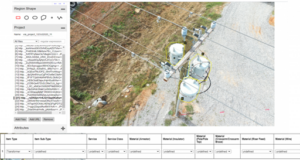
Figure 3: Any machine learning model is highly dependent on the training data going in, annotating images correctly was critical to model accuracy
Even with pre-defined annotation guidelines, Mosaic’s computer vision consultants faced annotation consistency problems because of multiple people annotating smaller sets of images. There were differences in annotation styles with some more tightly bound polygons than others and some misclassification from variable domain knowledge between annotators. Other problems were determining when to exclude an image from the training set if an asset was occluded beyond a defined threshold. Such challenges, if left unaddressed, make it impossible to maximize the performance of a computer vision model. Mosaic worked with the customer in an iterative process to improve the annotations, resulting in a high-quality data set for model training.
Feeding insights into decision processes
Once Mosaic had tuned the computer vision models to a level of accuracy the utility was satisfied with, the models needed to be validated on the customer’s image sets. Mosaic fed new inspection images into the models to make this AI actionable. In the picture below, you can see Mosaic’s model identifying different parts of the utility pole.
The energy operator can now feed new images into their inspection platform and have a machine accurately tag different parts of their infrastructure, saving them valuable time and identifying components that might need to be replaced or repaired.
AI-Driven Pricing for Clothing Retailers | Integrating AI into the Customer Experience
Retail firms need to embrace the application of machine learning to forecast demand and set prices. If they don’t, they fail to remain competitive. Just take a look at Amazon’s predictive stocking program from 2014; needless to say, they have continued improving that capability. Retail executives need to think more like tech companies, using AI and machine learning to predict how to stock stores and staff shifts and dynamically recommend products, and set prices at the individual consumer level.
A leading clothing manufacturer distributor and retailer of clothing realized they needed to fortify their pricing decisions with machine learning insights and contacted Mosaic.
Traditional retail pricing schemes for sales tend to be based on some combination of rate of sales and inventory on hand. Volume and profit goals typically inform price setting. Models tying price to demand can quickly become overwhelmingly complex, and therefore many retail outlets fall back on simple, uncontrolled demand modeling. This was just the situation for Mosaic’s retail clothing client: they knew that more variables influence consumer behavior than they were currently accounting for in their baseline demand models.
Additionally, they wanted to optimize the pricing mix across hundreds of different items to maximize both profit margin and volume of sales. In response, Mosaic built a multi-phased model that not only predicts demand at the item level but also optimizes the pricing mix while accounting for potentially limiting elements like inventory drawdown.
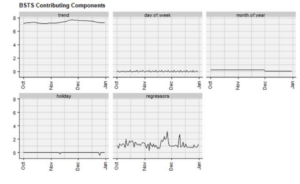
Figure 5: Bayesian structural time series algorithm helped control for several factors contributing to historical demand
Adoption
Mosaic was able to leverage a retail client’s historical promotion and transaction data to build a price optimization tool that successfully sets prices for a significant clearance sale and is currently being used enterprise-wide. The prices charged by Mosaic’s tool met helped the client meet both margin and volume goals for the sale while saving multiple hours of the client’s workforce. Additionally, the tool is flexible enough to be applied in various price-setting scenarios and has already seen further implementation by the client.
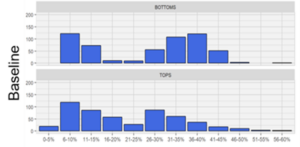
Bar graph depicting the lift in financial metrics after implementing Mosaic’s models to markdown pricing decisions.
Inertia is not going to cut it
Operating in today’s conditions requires creative thinking, agile decision making and embracing change. AI & Digital Transformation can support all these disciplines. If you are looking for a partner who can quickly uncover data driven insights, recommend ROI-driven actions, and deploy AI, with an eye towards organizational transformation, then you have come to the right place.

